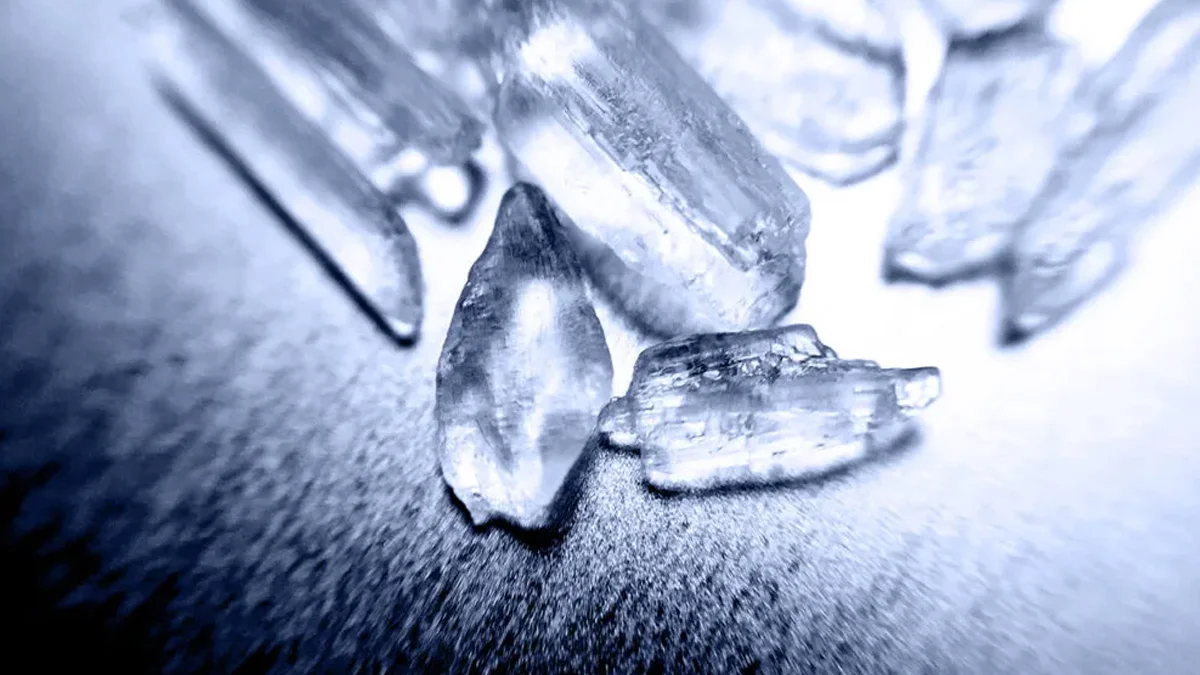Crystal methamphetamine, or crystal meth, is a potent and highly addictive stimulant that has gained significant attention in the United States. This powerful drug belongs to the amphetamine class and is characterized by its crystalline appearance, hence the name.
Its popularity in the illicit drug market is driven by its ability to induce intense euphoria and heightened energy levels, making it appealing to those seeking a rapid and intense high. Continue reading as we will delve into the different aspects of crystal meth.
Key Takeaways
Crystal methamphetamine is a powerful stimulant drug that affects the central nervous system (CNS). Here is what this article covers:
- Crystal meth is typically smoked, snorted, injected, or swallowed, leading to rapid and intense effects on the user.
- Meth can lead to increased wakefulness, euphoria, and decreased appetite, but also severe health issues and addiction.
- Crystal meth use and addiction are serious issues that require comprehensive approaches for prevention and treatment.
For support in overcoming meth addiction, contact The Haven Detox-Little Rock at (501) 271-3342 today.

What Is Crystal Methamphetamine
Crystal methamphetamine, commonly known as crystal meth, is a powerful and highly addictive stimulant drug. It appears as clear crystals resembling pieces of glass or bluish-white rocks. Chemically, it belongs to the amphetamine class and is made from pseudoephedrine or ephedrine, which are found in many OTC cold medications.
Street names for crystal meth include ice, glass, crank, and speed. Once ingested, crystal meth surges the release of dopamine in the brain, leading to intense feelings of pleasure and increased energy. This effect can last several hours, making it appealing to some users seeking prolonged euphoria and heightened alertness.
Originally, meth was developed in the early 20th century for medical purposes. During World War II, it was used to keep soldiers awake. Over time, due to its high potential for abuse, it became strictly regulated. However, illicit production surged in the 1960s and 1970s with the creation of crystal meth, a potent and purer form of the drug.
Today, crystal meth is classified as a Schedule II controlled substance in the US, which means it has a high potential for abuse and limited accepted medical use (such as in cases of severe attention deficit hyperactivity disorder or obesity). Possession, distribution, and manufacturing of meth are illegal under federal and state laws, carrying severe penalties.
How Crystal Methamphetamine Is Used
Crystal methamphetamine is typically consumed in various ways, each method affecting how quickly and intensely the drug takes effect.
Smoking
One common method of using crystal meth is by smoking it. Users heat the crystal meth crystals in a pipe, causing them to vaporize and produce smoke that is then inhaled into the lungs. Smoking crystal meth delivers the drug quickly to the brain, producing an intense and immediate high.
Snorting
Another way people use crystal meth is by snorting it through the nose. The drug is ground into a powder and then sniffed into the nasal passages. This method also delivers the drug rapidly into the bloodstream, though the effects may take slightly longer to kick in compared to smoking.
Injecting
Injecting crystal meth involves dissolving the crystals in water and then injecting the solution directly into a vein with a needle. This method offers the quickest and most intense high, but it also carries the highest risk of overdose, infections, and transmission of diseases like HIV/AIDS and hepatitis.
Oral Ingestion
Oral ingestion of crystal meth involves swallowing the drug either in pill form or dissolved in a beverage. This method produces a slower onset of effects compared to smoking, snorting, or injecting. Users may experience a less intense but longer-lasting high, with effects lasting up to several hours.
Each method carries its risks and impacts on physical and mental health, highlighting the importance of education and prevention efforts.
The Effects Of Crystal Methamphetamine
Crystal methamphetamine can have profound effects on both the body and mind.
Immediate Effects On The Body And Mind
When someone uses crystal methamphetamine, the drug quickly affects both their body and mind. It causes a surge of dopamine in the brain, resulting in euphoric feelings and increased energy.
Physically, it can result in rapid heart rate, heightened blood pressure, and dilated pupils. Mentally, users may experience increased alertness, reduced appetite, and a sense of invincibility. However, these immediate effects also come with risks, such as anxiety, paranoia, and aggression.
Short-Term Physical And Psychological Effects
In the short term, crystal methamphetamine can cause a range of physical and psychological issues. Physically, users may experience rapid breathing, irregular heartbeat, and tremors. They may also have difficulty sleeping and experience significant weight loss due to decreased appetite.
Psychologically, short-term use can lead to agitation, hallucinations, and severe mood swings. The drug’s impact on neurotransmitters can also impair judgment and decision-making abilities.
Long-Term Physical And Psychological Effects
Long-term use of crystal meth can have devastating effects on both the body and mind. Physically, it can lead to severe dental problems (“meth mouth”), weight loss, skin sores, and a weakened immune system. Chronic use may also result in cardiovascular issues, liver and kidney damage, and even brain damage. Mentally, long-term users often experience anxiety, depression, paranoia, and cognitive deficits. These effects can persist even after cessation of use, making recovery challenging.
Understanding these effects of crystal methamphetamine can help people make sound decisions about their health and well-being.
Risks And Dangers Of Crystal Methamphetamine Use
Crystal methamphetamine poses significant risks to individuals who use it, ranging from health dangers to societal consequences. Let’s explore them:
Risk Of Overdose
One of the most severe risks associated with crystal methamphetamine use is the potential for overdose. Because the drug stimulates the central nervous system (CNS), excessive doses can overwhelm the body’s ability to regulate vital functions like heart rate and temperature. Symptoms of overdose may include rapid breathing, chest pain, seizures, and even coma. Immediate medical attention is vital in cases of suspected drug overdose to prevent life-threatening complications.
Risk Of Addiction
Crystal methamphetamine is highly addictive, meaning users can quickly develop a compulsive urge to seek and use the drug despite negative consequences. Methamphetamine addiction alters brain chemistry, making it difficult for individuals to control their use. Over time, tolerance builds, requiring larger doses to achieve the desired effects. Symptoms of meth withdrawal, such as anxiety, depression, fatigue, and intense drug cravings, can be severe, further reinforcing the cycle of addiction.
Social And Legal Consequences
The use of crystal meth can have distressing social and legal consequences. Socially, it can strain relationships with family members and friends, leading to isolation and mistrust. Users may neglect work, school, or home responsibilities, further exacerbating personal challenges. Legally, possession, distribution, or manufacture of crystal meth is illegal in the United States and can result in severe legal penalties, including fines, imprisonment, and a criminal record that can impact future opportunities.
Understanding these risks and dangers is crucial for making informed decisions and seeking appropriate support.
Prevention And Treatment Options
Crystal methamphetamine use and addiction are serious issues requiring comprehensive approaches for prevention and treatment. Let’s explore some of these methods:
Prevention Strategies
Preventing the use of methamphetamine involves a combination of education and adopting healthy habits.
- Educating oneself and others about the risks and consequences of drug use is crucial. Learning healthy coping mechanisms, such as managing stress through exercise or hobbies, can help reduce the likelihood of turning to drugs. A healthy lifestyle, including balanced nutrition and regular sleep patterns, supports overall well-being and resilience.
- Building a strong support network of friends, family, or counselors provides encouragement and guidance during challenging times. Developing resilience, or the ability to bounce back from setbacks, strengthens one’s resolve to avoid substance use. Avoiding triggers, situations, or environments that may tempt drug use and seeking help early if struggling with substance use are proactive steps toward prevention.
Treatment Options
Treatment for crystal meth addiction includes various approaches tailored to individual needs.
- Medical detoxification under medical supervision helps manage withdrawal symptoms safely. Behavioral therapies, like cognitive-behavioral therapy (CBT), help individuals identify and change harmful behaviors and thought patterns associated with drug use. Medication-assisted treatment (MAT) may be utilized to reduce cravings and withdrawal symptoms.
- Family therapy involves helping loved ones recover and fostering healthier relationships and support networks. Support groups like Narcotics Anonymous provide peer support and accountability. Holistic approaches, such as mindfulness, yoga, and art therapy, complement traditional therapies by promoting overall wellness and stress reduction.
Combining effective prevention strategies with a range of treatment options is essential in addressing crystal meth use and addiction comprehensively.
Frequently Asked Questions (FAQ)
Crystal methamphetamine, often called crystal meth or just meth, is a powerful stimulant drug. It appears as clear crystals resembling glass or bluish-white rocks. This form of methamphetamine is typically smoked, snorted, or injected to produce a quick and intense high.
What sets crystal meth apart from other forms of meth, like powder or pills, is its purity and potency. Crystal meth is more concentrated and can lead to faster addiction and more severe health consequences. Its health effects can be highly damaging, making it a dangerous substance to abuse.
Signs of crystal meth use include extreme energy, rapid speech, dilated pupils, and decreased appetite. Users may also exhibit hyperactivity, nervousness, and intense mood swings. Physical signs like weight loss, skin sores, and dental problems (often called “meth mouth”) can also indicate use.
Behavioral changes such as secretive behavior, neglecting responsibilities, and sudden financial issues might be evident. Paranoia, hallucinations, and erratic sleep patterns are also common. If you suspect someone is using crystal meth, look for these signs alongside sudden changes in appearance and behavior.
Crystal meth is highly damaging to both physical and mental health. It can cause severe addiction, leading to compulsive drug-seeking behavior and withdrawal symptoms when not using. Physically, it can result in rapid weight loss, dental problems, skin sores, and an increased risk of infections.
Long-term use can harm the brain, causing memory loss, confusion, and mood disturbances. Socially, it can strain relationships and lead to legal and financial problems. Treatment for crystal meth addiction is challenging but possible with support. Early intervention is crucial to minimize the harmful effects.
Transform Your Life At The Haven Detox-Little Rock
Struggling with substance use disorder (SUD) can feel overwhelming, but remember, recovery is within reach. At The Haven Detox-Little Rock, we’re here to guide you through every step of your journey toward a healthier, addiction-free life.
Start with our medical detox program, where we safely rid your body of harmful substances. Then, move into our intensive, 24/7 residential rehab, where our expert team provides round-the-clock care. You’ll benefit from proven therapies, medications, NAD IV therapy, and holistic approaches, all tailored to equip you with the tools to conquer addiction.Don’t wait another day to reclaim your life. Contact us at (501) 271-3342 for detailed information and take the first step towards a healthier future.




